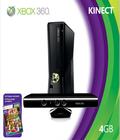While Microsoft and Sony put the full weight of their hardware design prowess into developing high-definition consoles that rival contemporary gaming PCs for graphical fidelity and overall performance, Nintendo merely remodeled their last-generation, standard-definition GameCube, added a control system novel to mass-market gaming, and created Wii, a runaway bestseller. Diehard Xbox- and PlayStation-brand partisans can duke it out over the relative merits of two consoles that for the most part deliver evenly matched experiences, the tale of the tape makes Wii the clear winner in hardware sales for this console generation.
With both major players in HD consoles expecting an especially extended life cycle this generation, there was nothing for them to do but scramble around, seeking something similar to, hopefully better than, Wii's control system. Not much could be done to stall juggernaut Wii, but motion-control enhancements to PS3 and Xbox 360 would at least keep those consoles competitive with a first-to-market Wii successor from Nintendo.
Sony released PS Move, a control system that, despite its overall solid, exceptionally accurate execution, was satisfied merely improving on the basic concept of console motion control established by Wii. Microsoft trod a different path, acquiring and further developing a technology that, while not necessarily revolutionary in advanced interface design laboratories, certainly is something brand new and fresh for console gamers. They call it Kinect.
PS3 and Wii's motion control systems require a quite a few little plastic gadgets, but Kinect is a deceptively simple device: a squat, sleek, oblong unit set upon a little pedestal stand; stuffed with a sensor array including four microphones and two cameras; and a motor-driven tilt mechanism. For all this extra sensory perception, Kinect requires its own main power connection and AC adapter. It can't run off standard Xbox 360 USB ports or batteries, although the redesigned Xbox 360 S does have a Kinect-ready port that powers the device. This isn't much of an impasse for owners of the original form factor Xbox 360s, since Kinect isn't really a controller and sits close by the console, which itself requires ready access to a wall outlet or power-strip extension.
Presuming you have an Xbox 360 S, or older 360 and free AC outlet, Kinect setup is a fairly straightforward matter. Though some initial calibration is required, unlike many game peripherals, it's not a one-time or infrequent affair. Starting games, Kinect will try to recognize you. Adding or removing people from active play, Kinect will account for that. It's tantamount to Kinect constantly calibrating and recalibrating itself. Fortunately, the motor-driven tilt mechanism and excellent core software design make this a quick, painless process that doesn't greatly interrupt the flow of gameplay.
Kinect is designed to be used controller-free, even in the Dashboard. At first, you may want to keep a standard wireless controller handy, but access to Kinect-specific menus, launching and quitting Kinect games, and managing settings and other in-game minutiae can all be accomplished with Kinect alone, via gestures and voice commands.
Kinect does a very good job recognizing various natural hand gestures and preset voice commands directed by a variety of users, from small children to adults. For longtime gamers, the most annoying thing about Kinect is that in the context of gaming we've become accustomed to dual-stick controllers as our interface to the console. It's second nature. Early in my time with Kinect, I found myself a little at loss without my familiar controller, though I knew the device would do as commanded if only I waved at it. Children and adults with lighter console gaming experience will catch on faster, but almost everyone will get used to it sooner rather than later.
The only significant complication for Kinect is the size of open floor space required for flawless operation. If you live and game in a large suburban home with entire areas of the house you haven't walked through in a couple of months, you'll have no problem. Kinect isn't as well suited for efficient urban apartments, spare bedrooms or dorm rooms. In most cases, these latter arrangements won't prevent you from enjoying Kinect, but you'll probably have to move the furniture around to play games. That's unfortunate because once configured, Kinect is a virtually transparent control interface.
Certainly Kinect is a fascinating thing, marrying several different advanced hardware and software technologies to create an entirely new gaming experience, along with gestural and voice controls for some of the non-gaming entertainment features of an Xbox 360. What matters with Kinect — or any gaming hardware, for that matter — are the actual games. The titles initially available for Kinect are squarely placed in the party-game category. Though these things aren't common favorites of daily gamers, they do best suit early Kinect adopters — so-called casual gamers and anyone who wants to buy and show off a neat new entertainment device to anyone who'll stop long enough to watch it in action. To watch Kinect is to immediately want to play Kinect. The gee-whiz factor is off the charts.
Kinect is a true original in gaming peripherals. With any change in underlying technologies, there's often a longish waiting period for availability of many good games that take full advantage of the new features. Priced at $150 not bundled with an Xbox 360 S console, Kinect is the most expensive of the motion control options for HD consoles, and it costs almost as much as a whole Wii system. Consider, though, Kinect does something very unique, completely different than PS Move and Wii, and, also, Kinect Adventures, a thoroughly entertaining if not brilliant minigame collection, is included. Kinect's price tag may seem a bit high, but the device's quality and value are equally high. For veteran gamers who own an Xbox 360 and have any interest in a very different, exciting and enjoyable gaming experience, Kinect is well worth the price. If you have gaming children, or holdout friends and relatives who remain video game averse, Kinect is practically a required investment.
Score: 9.5/10
More articles about Kinect











 Kinect brings games and entertainment to life in extraordinary new ways — no controller required. Simple to use and fun to play, Kinect allows owners to jump into Kinect-enabled games for any type of play.The Kinect sensor recognizes you, responds to your gestures, listens to your voice and works with every X360 console.
Kinect brings games and entertainment to life in extraordinary new ways — no controller required. Simple to use and fun to play, Kinect allows owners to jump into Kinect-enabled games for any type of play.The Kinect sensor recognizes you, responds to your gestures, listens to your voice and works with every X360 console.





